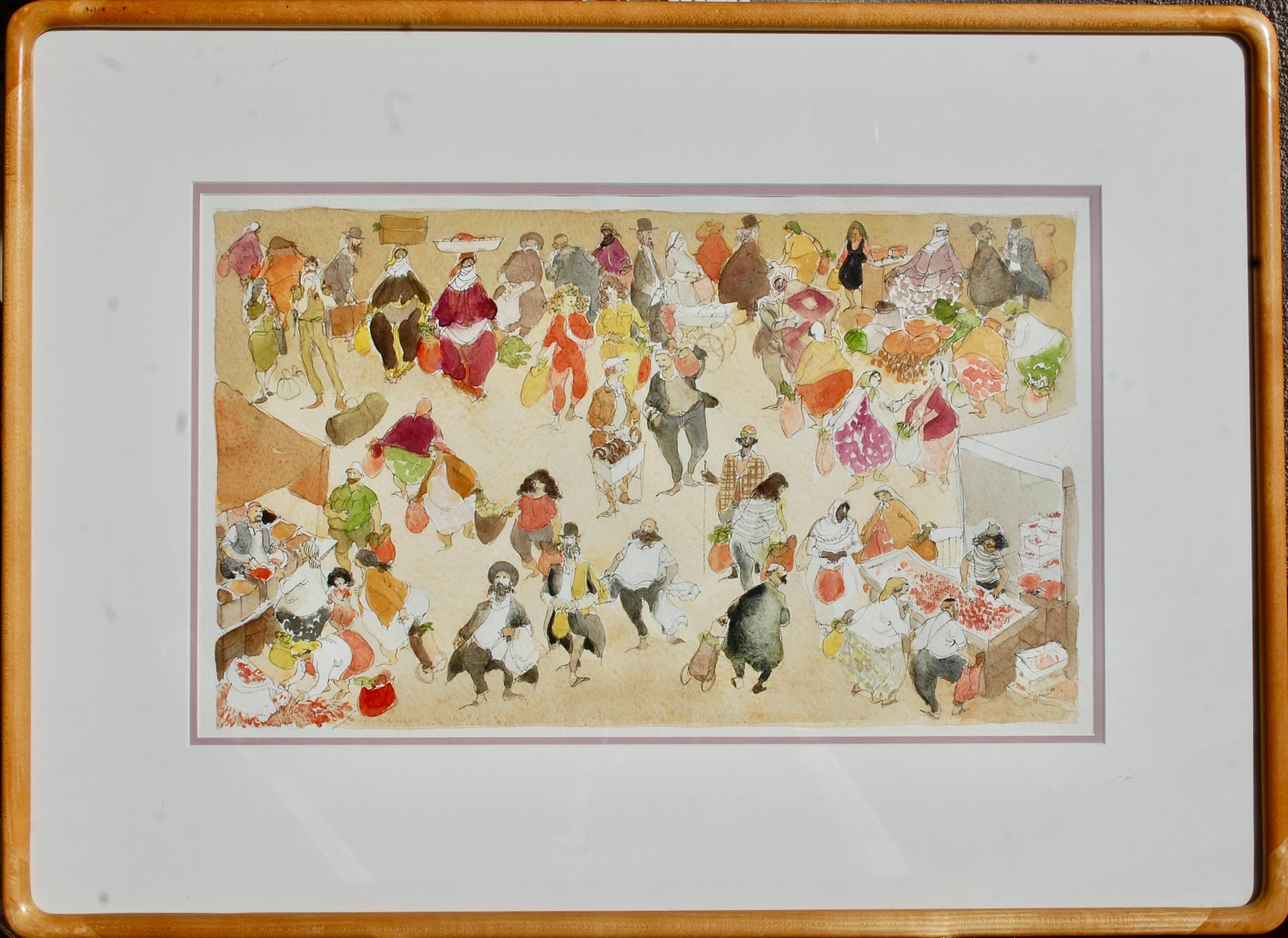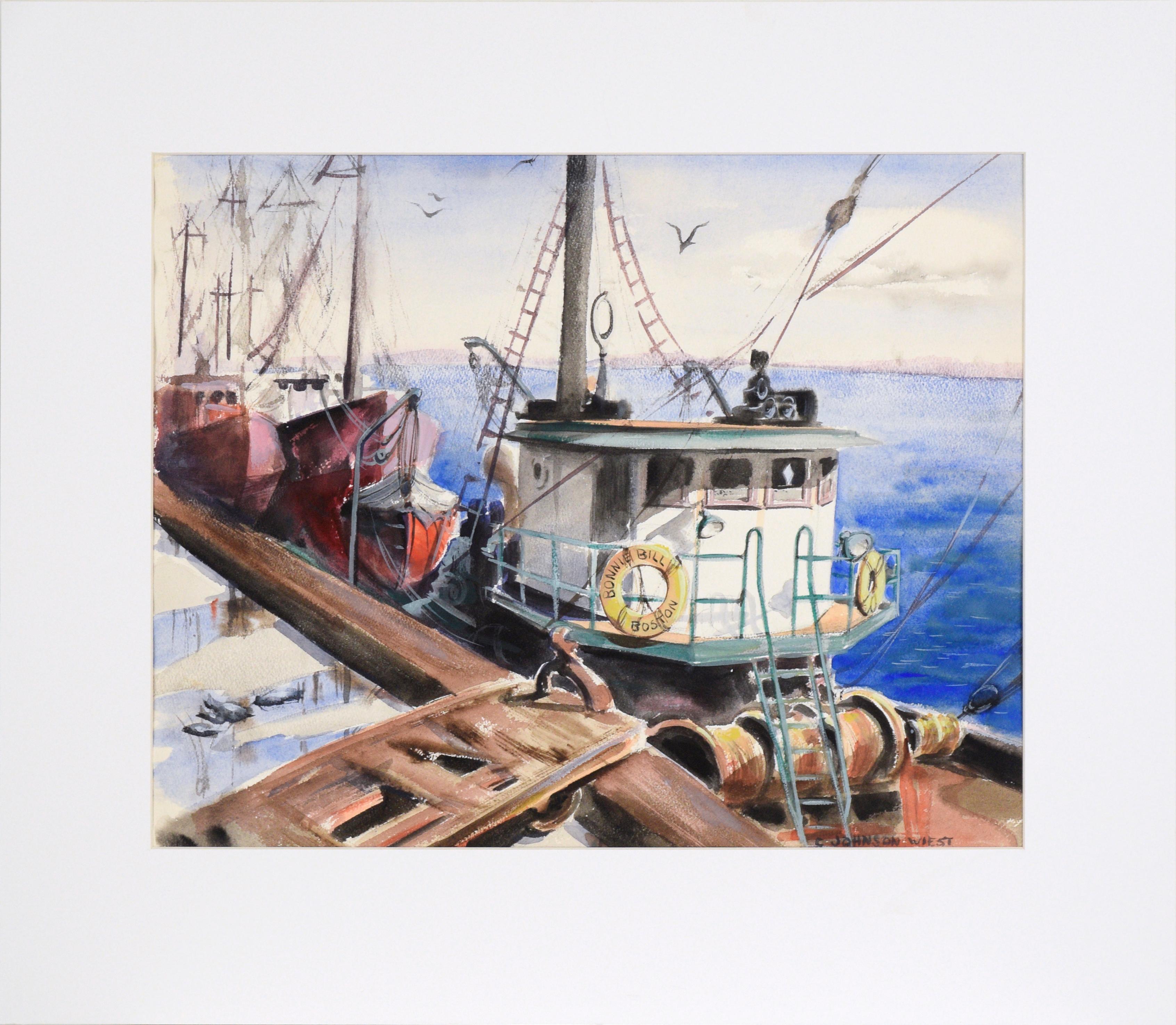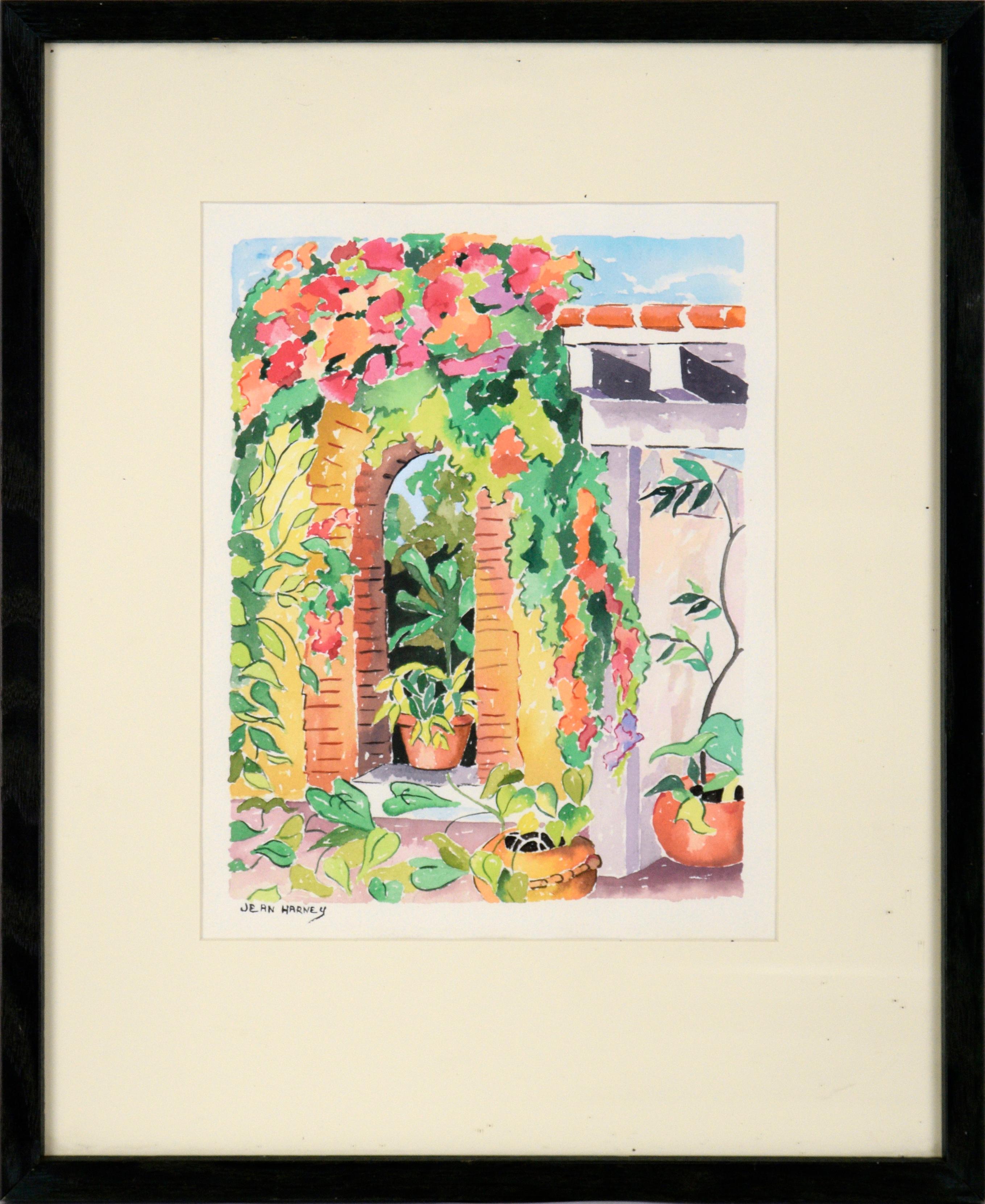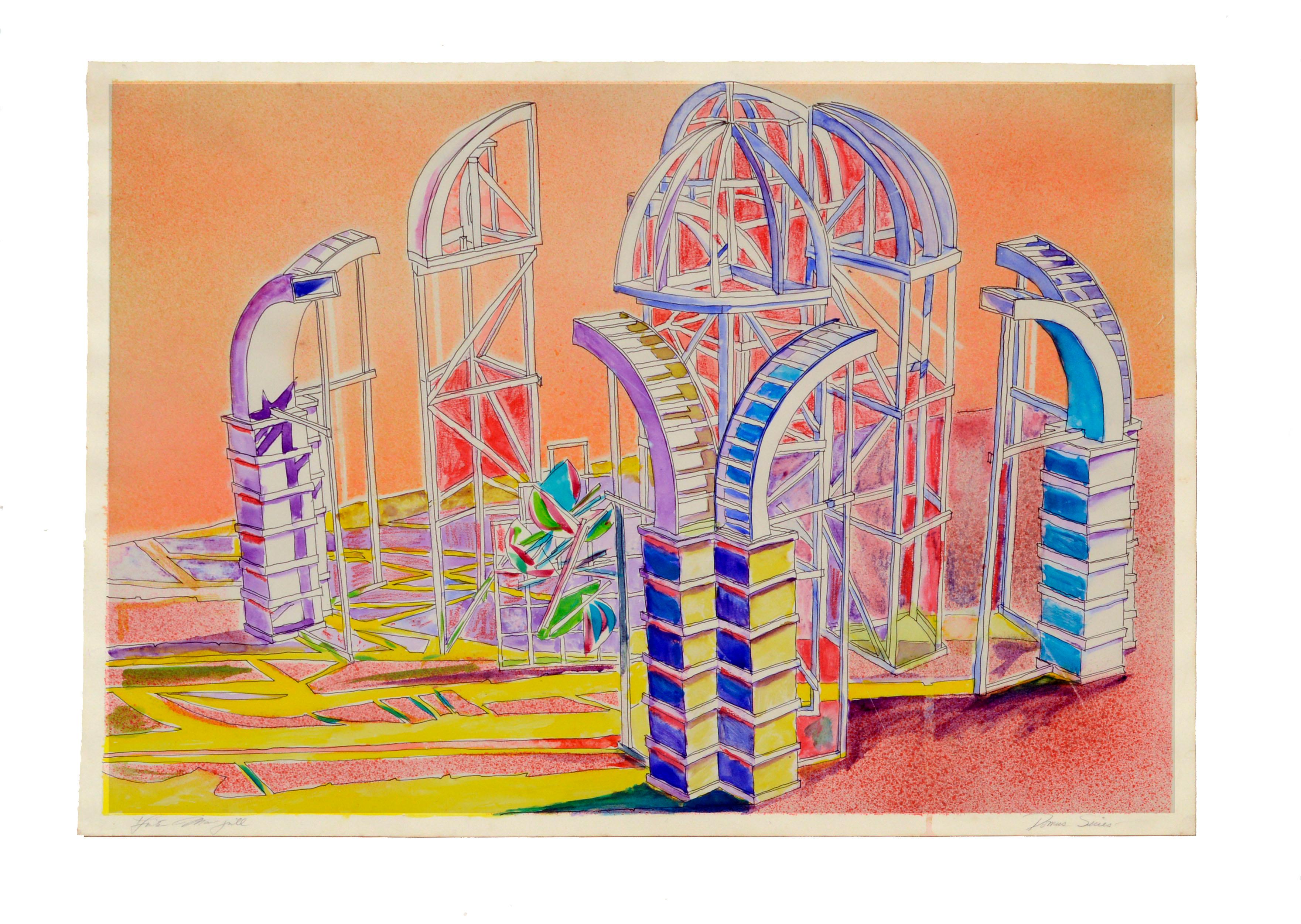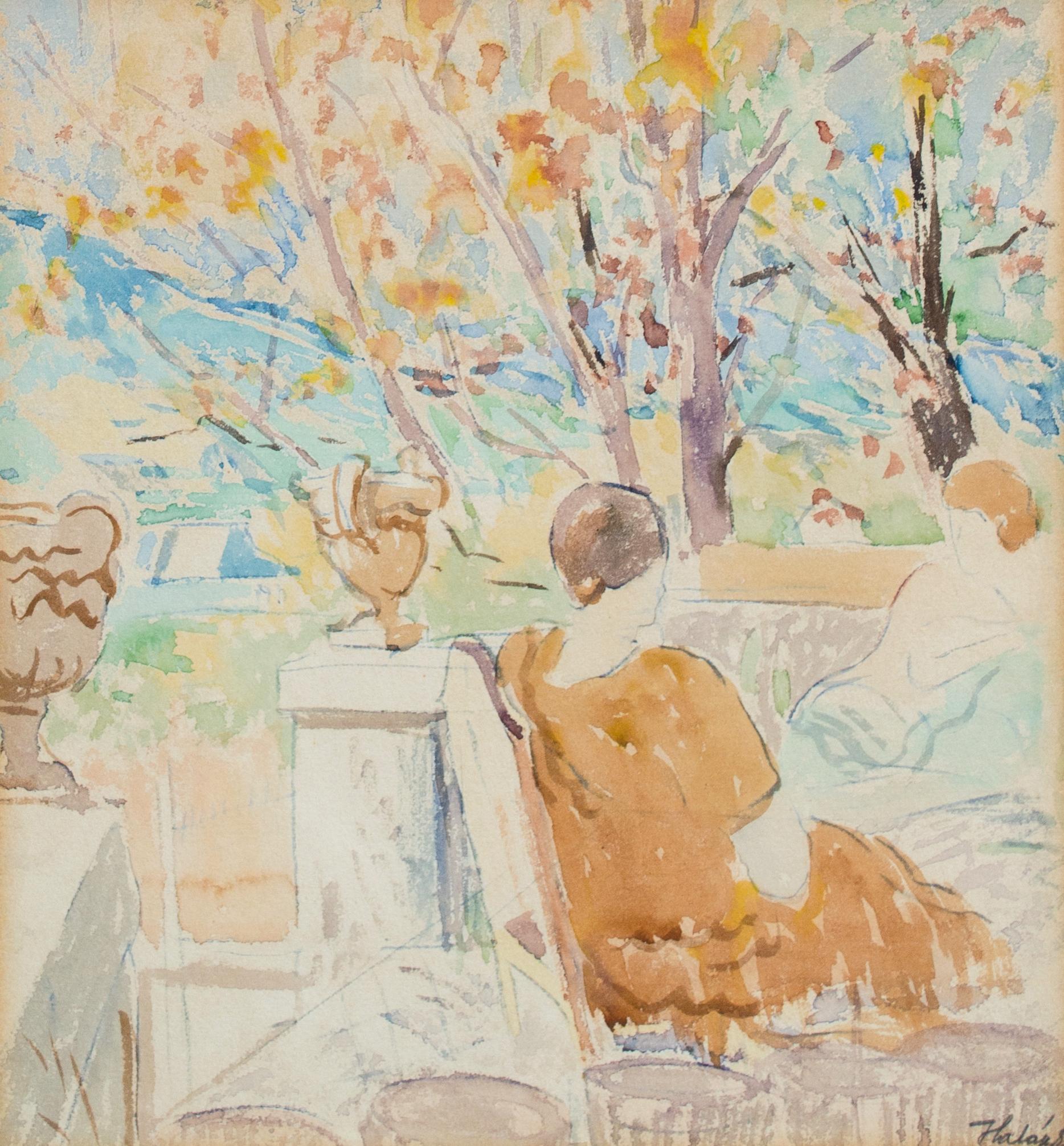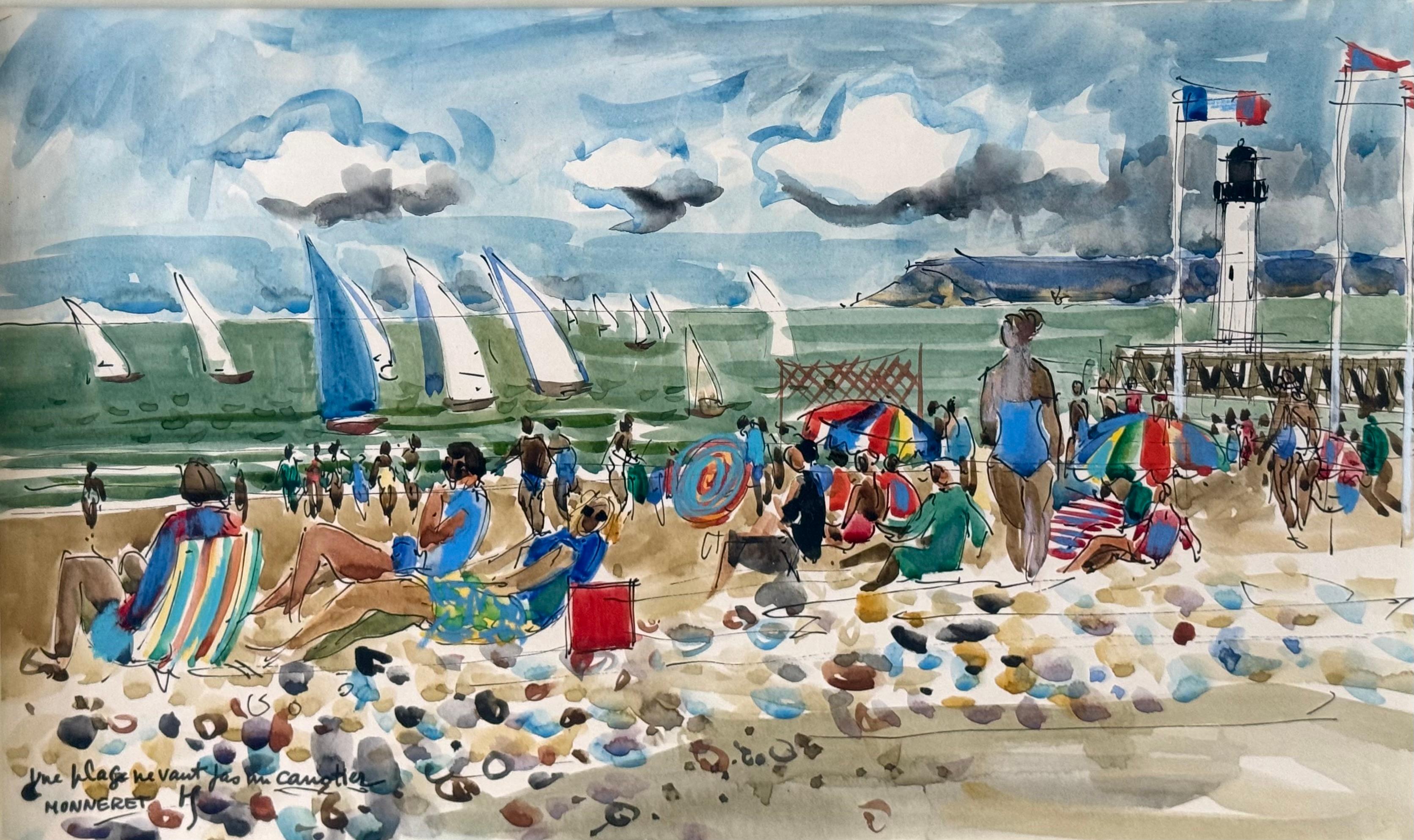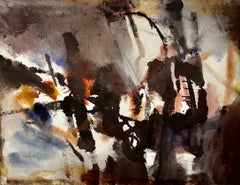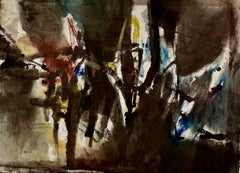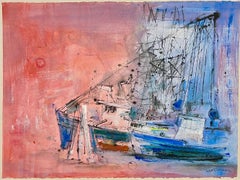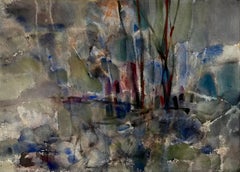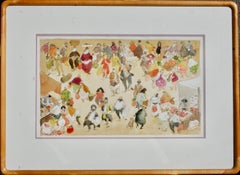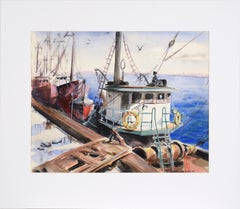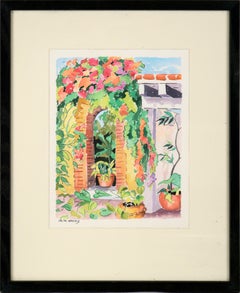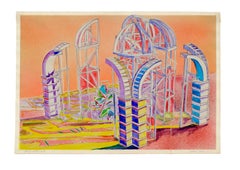Items Similar to Western Wall, Jerusalem Watercolor
Want more images or videos?
Request additional images or videos from the seller
1 of 7
Shmuel KatzWestern Wall, Jerusalem Watercolor
About the Item
Beautiful painting of the Kotel Hamaravi The Western (Wailing) Wall in Jerusalem, Israel. sight is 27X19 inches.
Shmuel Katz (Hebrew: שמואל כ"ץ) (August 18, 1926 – March 26, 2010) was an Israeli artist, illustrator, and cartoonist. A Holocaust survivor and postwar immigrant to Mandate Palestine via the detention camps on Cyprus, he figured prominently in Israeli illustration and newspaper cartooning, widely exhibiting and publishing his drawings and paintings at home and abroad, for which he won numerous local and international awards. His sketches and watercolors are known for their sprightly lines and touches of humor
Samuel Alexander (Sandor) Katz was born in Vienna, Austria, to parents of Hungarian origin. Following the Anschluss, Austria’s annexation by Nazi Germany in March 1938, the family relocated to Hungary. After the Nazi invasion of Hungary in 1944, he was deported to a forced labor camp in Yugoslavia from which he escaped to Budapest where he was among the thousands of Jews hidden in the "Glass House" shelter operated by Swiss diplomat Carl Lutz, until the arrival of the Soviet Red Army in mid-February 1945.
In Budapest, Katz joined the youth movement Hashomer Hatzair. He began studying architecture there in the Budapest University of Technology and Economics. In 1946, in the framework of the Aliyah Bet illegal immigration, he sailed aboard the Knesset Israel which was apprehended by the British and its passengers interned in a detention camp on Cyprus.
In 1947, Katz secured a legal immigration certificate as a member of the “First of May” nucleus group of Hashomer Hatzair. The group did its pioneering training at Kibbutz Eilon on the Lebanese border, and on October 8, 1948, became the founders of Kibbutz Ga'aton in the Western Galilee, where Katz spent the rest of his life. He designed the kibbutz dining room whose interior features Hungarian folkloristic wood carving.
During the years 1950–1953 Shemuel Katz illustrated Mishmar Layeladim, the weekly children’s supplement to the Mapam party’s newspaper, Al HaMishmar. In 1953–1954, he enrolled in the École nationale supérieure des Beaux-Arts in Paris, France, where he studied lithography, copperplate etching, fresco, and music, and toured the lands of Western Europe. In 1955, he joined the editorial board of Al HaMishmar as illustrator and graphics editor. In 1958, he traveled through East Africa, a journey whose impressions influenced his artistic and technical style and led to the 1962 publication of A Journey to the Land of Kush together with author Nathan Shaham. In 1976 he visited Iran, and the following November in Tehran exhibited artworks featuring Iran and Jerusalem. In 1979, Katz paid two visits to Egypt with the “Autonomy” delegation and was granted a private interview with Egyptian president Anwar Sadat. In 1983, he visited Hungary as a member of a delegation from Peace Now.
Shemuel Katz’s artworks have been exhibited extensively in Israel and abroad. His watercolors of Jerusalem have been reproduced as posters and postcards. His courtroom sketches of Adolf Eichmann’s trial in Jerusalem, 1961, are held in the art collection of Yad Vashem, Israel’s Holocaust Remembrance Authority. As an artist in the IDF, he sketched soldiers on guard and at war. Katz is well known as the illustrator of hundreds of books, especially for Sifriat Poalim, the Kibbutz Artzi movement's publishing house. Especially popular are his illustrated classics of Israeli children’s literature Shmuel Katz (Hebrew: שמואל כ"ץ) (August 18, 1926 – March 26, 2010) was an Israeli artist, illustrator, and cartoonist. A Holocaust survivor and postwar immigrant to Mandate Palestine via the detention camps on Cyprus, he figured prominently in Israeli illustration and newspaper cartooning, widely exhibiting and publishing his drawings and paintings at home and abroad, for which he won numerous local and international awards. His sketches and watercolors are known for their sprightly lines and touches of humor.
Awards and honors
1959 – Medal at the International Exhibition of Book Art, Leipzig, Germany
1961 – First prize in Drawing and Watercolor of the Biennale for Young Artists, Paris, France
1974 – Nordau Prize for Art, Tel Aviv, Israel
1985 – Nachum Gutman Memorial Award of the Tel Aviv municipality
1997 – International Award for Caricature, Budapest, Hungary
2006 – “Dosh” Memorial Award for Caricature, Einav Center, Tel Aviv
2007 – First “Golden Pencil” Award of the Israeli Museum of Caricature and Comic Art, Holon, Israel
- Creator:Shmuel Katz (1926 - 2010, Austrian, Israeli)
- Dimensions:Height: 24 in (60.96 cm)Width: 32 in (81.28 cm)
- Medium:
- Period:
- Condition:matted not framed.
- Gallery Location:Surfside, FL
- Reference Number:1stDibs: LU38210640812
About the Seller
4.9
Platinum Seller
Premium sellers with a 4.7+ rating and 24-hour response times
Established in 1995
1stDibs seller since 2014
1,765 sales on 1stDibs
Typical response time: 1 hour
- ShippingRetrieving quote...Shipping from: Surfside, FL
- Return Policy
Authenticity Guarantee
In the unlikely event there’s an issue with an item’s authenticity, contact us within 1 year for a full refund. DetailsMoney-Back Guarantee
If your item is not as described, is damaged in transit, or does not arrive, contact us within 7 days for a full refund. Details24-Hour Cancellation
You have a 24-hour grace period in which to reconsider your purchase, with no questions asked.Vetted Professional Sellers
Our world-class sellers must adhere to strict standards for service and quality, maintaining the integrity of our listings.Price-Match Guarantee
If you find that a seller listed the same item for a lower price elsewhere, we’ll match it.Trusted Global Delivery
Our best-in-class carrier network provides specialized shipping options worldwide, including custom delivery.More From This Seller
View AllModernist Abstract Expressionist Watercolor Painting Bauhaus Weimar Pawel Kontny
By Pawel Kontny
Located in Surfside, FL
Abstract watercolor composition bearing the influence of the earlier color-block compositions of Paul Klee.
Pawel August Kontny, (Polish-German-American artist) He was born in Laurahuette, Poland, in 1923, the son of a wealthy pastry shop owner. In 1939 he began studying architecture in Breslau where he was introduced to the European masters and to the work of some of the German Expressionists, soon afterward banned as "degenerate artists" and removed from museums throughout Germany by the Nazi regime. His studies were interrupted by World War II. Drafted into the German army, traveling in many countries as a soldier, he sketched various landscapes but in 1945, he was captured and held as a prisoner of war in Italy. After the war, he studied at the Union of Nuremberg Architects to help design buildings to replace ones destroyed in the war. He recorded his impressions of the local population and the landscapes through his watercolors and drawings. Pawel Kontny thereafter moved to Nuremberg, Germany, becoming a member of the Union of Nuremberg Architects and helping to rebuild the city's historic center. He soon decided to concentrate on his professional art career. He married Irmgard Laurer, a dancer with the Nuremberg Opera. Pavel Kontny 's career as an artist was launched with his participation in an all German exhibition, held at the Dusseldorf Museum in 1952. He held one-man shows in Germany, Switzerland and the United States. During his trip to the United States in 1960, Kontny became instantly enamored with Colorado, and decided to relocate to Cherry Hills with his wife and two children. He quickly established himself in the local art community, being affiliated for a time with Denver Art Galleries and Saks Galleries. His subject matter became the Southwest. During this time he received the Prestigious Gold Medal of the Art Academy of Rome. His extensive travel provided material for the paintings he did using his hallmark marble dust technique. he also worked equally in pastel, watercolor, charcoal and pencil-and-ink. in a style which merged abstraction and realist styles, influenced by Abstract Expressionist painting and South Western American landscapes. This one bears the influence of Sam Francis. In the early 1960s he was one of only a few European-born professional artists in the state, a select group that included Herbert Bayer (1900-1985), a member of the prewar Bauhaus in Weimar and Dessau, Germany, and Roland Detre (1903-2001), a Hungarian modernist painter. As a Denver, Colorado resident, Pavel Kontny exhibited at galleries and museums throughout the United States, Germany and Japan. There, he was inspired by frequent trips to Native American pueblos in the Southwest, as well as by the study of the Plains Indians of Montana and Wyoming. Over the years Kontny had a number of students and generously helped young artist by hosting exhibitions at his Cherry Hills home. For many years he generously donated his paintings to support charitable causes in Denver. Influences during his European years included German pastelist C.O. Muller, German Informel painter Karl Dahmen and Swiss artist, Hans Erni. In the early 1950s his painting style showed the influence of the Die Brücke (The Bridge), a group of German expressionist artists formed in Dresden in 1905 who had a major impact on the evolution of modern art in the twentieth century in Germany. By the middle of the decade his style incorporated more referential abstraction and total abstraction, resulting in part from his study of Hans Hartung, a German artist based in Paris who exhibited his gestural abstract work in Germany. The American moon landing in 1969 inspired Paul Kontny...
Category
20th Century American Modern Abstract Drawings and Watercolors
Materials
Watercolor, Archival Paper
Modernist Abstract Expressionist Watercolor Painting Bauhaus Weimar Pawel Kontny
By Pawel Kontny
Located in Surfside, FL
Abstract watercolor composition bearing the influence of the earlier color-block compositions of Paul Klee.
Pawel August Kontny, (Polish-German-American artist) He was born in Laurahuette, Poland, in 1923, the son of a wealthy pastry shop owner. In 1939 he began studying architecture in Breslau where he was introduced to the European masters and to the work of some of the German Expressionists, soon afterward banned as "degenerate artists" and removed from museums throughout Germany by the Nazi regime. His studies were interrupted by World War II. Drafted into the German army, traveling in many countries as a soldier, he sketched various landscapes but in 1945, he was captured and held as a prisoner of war in Italy. After the war, he studied at the Union of Nuremberg Architects to help design buildings to replace ones destroyed in the war. He recorded his impressions of the local population and the landscapes through his watercolors and drawings. Pawel Kontny thereafter moved to Nuremberg, Germany, becoming a member of the Union of Nuremberg Architects and helping to rebuild the city's historic center. He soon decided to concentrate on his professional art career. He married Irmgard Laurer, a dancer with the Nuremberg Opera. Pavel Kontny 's career as an artist was launched with his participation in an all German exhibition, held at the Dusseldorf Museum in 1952. He held one-man shows in Germany, Switzerland and the United States. During his trip to the United States in 1960, Kontny became instantly enamored with Colorado, and decided to relocate to Cherry Hills with his wife and two children. He quickly established himself in the local art community, being affiliated for a time with Denver Art Galleries and Saks Galleries. His subject matter became the Southwest. During this time he received the Prestigious Gold Medal of the Art Academy of Rome. His extensive travel provided material for the paintings he did using his hallmark marble dust technique. he also worked equally in pastel, watercolor, charcoal and pencil-and-ink. in a style which merged abstraction and realist styles, influenced by Abstract Expressionist painting and South Western American landscapes. This one bears the influence of Sam Francis. In the early 1960s he was one of only a few European-born professional artists in the state, a select group that included Herbert Bayer (1900-1985), a member of the prewar Bauhaus in Weimar and Dessau, Germany, and Roland Detre (1903-2001), a Hungarian modernist painter. As a Denver, Colorado resident, Pavel Kontny exhibited at galleries and museums throughout the United States, Germany and Japan. There, he was inspired by frequent trips to Native American pueblos in the Southwest, as well as by the study of the Plains Indians of Montana and Wyoming. Over the years Kontny had a number of students and generously helped young artist by hosting exhibitions at his Cherry Hills home. For many years he generously donated his paintings to support charitable causes in Denver. Influences during his European years included German pastelist C.O. Muller, German Informel painter Karl Dahmen and Swiss artist, Hans Erni. In the early 1950s his painting style showed the influence of the Die Brücke (The Bridge), a group of German expressionist artists formed in Dresden in 1905 who had a major impact on the evolution of modern art in the twentieth century in Germany. By the middle of the decade his style incorporated more referential abstraction and total abstraction, resulting in part from his study of Hans Hartung, a German artist based in Paris who exhibited his gestural abstract work in Germany. The American moon landing in 1969 inspired Paul Kontny...
Category
20th Century American Modern Abstract Drawings and Watercolors
Materials
Watercolor, Archival Paper
Gouache Watercolor Painting, Nantucket Harbor Boats American Deaf Modernist Art
By Robert Freiman
Located in Surfside, FL
Abstract harbor scene with boats, in bold, vivid colors on heavy mould made paper.
Hand signed and dated, 1980
22 X 30 not frame
Robert Freiman, deaf from birth, was born in March 1917 in New York City. He attended an oral program near his home and later transferred to the Lexington School for the Deaf when he was six. Early in his childhood, his love for drawing, painting and studying became apparent, and as an adult, he continued his studies in New York at the National Academy of Design, Pratt Institute, the Art Students League and the Parsons School of Design. In Paris, France he studied at the Ecole des Beaux Arts. Bob Freiman was especially focused on painting portraits and figures in motion in various mediums, especially the mixed-media combination of watercolor, acrylic and pen. Among his subjects were acrobats, ballet dancers, cyclists and other athletes. He as well focused on abstracts for a time, discovering new media in his works with quick brushwork and expressive movements.
In the latter part of his career, his style became abstract and surreal with images of metaphysical landscapes with architectural elements such as arches, towers, pyramids and castles floating in the air. The famed art critic Pierre Rouve wrote: “It is therefore refreshing to see them revitalized by the colourist wealth and virile handwriting of Robert Freiman, probably the best American water-colorist since John Marin. He worked in Provincetown and Nantucket and regularly exhibited there. He showed at Doll & Richards gallery of Boston alongside John Chetcuti, Lloyd Goodrich, Tod Lindenmuth, William Meyerowitz, Dwight Shepler, Elizabeth O'Neill Verner, Stanley Woodward, Andrew Wyeth, and others. His work bears the influence of the mid century school of Paris in particular Jean Carzou. He was a regular exhibitor at the Sidewalk Art...
Category
1980s Expressionist Figurative Paintings
Materials
Watercolor, Gouache, Archival Paper
Modernist Abstract Expressionist Watercolor Painting Bauhaus Weimar Pawel Kontny
By Pawel Kontny
Located in Surfside, FL
Abstract watercolor composition bearing the influence of the earlier color-block compositions of Paul Klee.
Pawel August Kontny, (Polish-German-American artist) He was born in Laurahuette, Poland, in 1923, the son of a wealthy pastry shop owner. In 1939 he began studying architecture in Breslau where he was introduced to the European masters and to the work of some of the German Expressionists, soon afterward banned as "degenerate artists" and removed from museums throughout Germany by the Nazi regime. His studies were interrupted by World War II. Drafted into the German army, traveling in many countries as a soldier, he sketched various landscapes but in 1945, he was captured and held as a prisoner of war in Italy. After the war, he studied at the Union of Nuremberg Architects to help design buildings to replace ones destroyed in the war. He recorded his impressions of the local population and the landscapes through his watercolors and drawings. Pawel Kontny thereafter moved to Nuremberg, Germany, becoming a member of the Union of Nuremberg Architects and helping to rebuild the city's historic center. He soon decided to concentrate on his professional art career. He married Irmgard Laurer, a dancer with the Nuremberg Opera. Pavel Kontny 's career as an artist was launched with his participation in an all German exhibition, held at the Dusseldorf Museum in 1952. He held one-man shows in Germany, Switzerland and the United States. During his trip to the United States in 1960, Kontny became instantly enamored with Colorado, and decided to relocate to Cherry Hills with his wife and two children. He quickly established himself in the local art community, being affiliated for a time with Denver Art Galleries and Saks Galleries. His subject matter became the Southwest. During this time he received the Prestigious Gold Medal of the Art Academy of Rome. His extensive travel provided material for the paintings he did using his hallmark marble dust technique. he also worked equally in pastel, watercolor, charcoal and pencil-and-ink. in a style which merged abstraction and realist styles, influenced by Abstract Expressionist painting and South Western American landscapes. This one bears the influence of Sam Francis. In the early 1960s he was one of only a few European-born professional artists in the state, a select group that included Herbert Bayer (1900-1985), a member of the prewar Bauhaus in Weimar and Dessau, Germany, and Roland Detre (1903-2001), a Hungarian modernist painter. As a Denver, Colorado resident, Pavel Kontny exhibited at galleries and museums throughout the United States, Germany and Japan. There, he was inspired by frequent trips to Native American pueblos in the Southwest, as well as by the study of the Plains Indians of Montana and Wyoming. Over the years Kontny had a number of students and generously helped young artist by hosting exhibitions at his Cherry Hills home. For many years he generously donated his paintings to support charitable causes in Denver. Influences during his European years included German pastelist C.O. Muller, German Informel painter Karl Dahmen and Swiss artist, Hans Erni. In the early 1950s his painting style showed the influence of the Die Brücke (The Bridge), a group of German expressionist artists formed in Dresden in 1905 who had a major impact on the evolution of modern art in the twentieth century in Germany. By the middle of the decade his style incorporated more referential abstraction and total abstraction, resulting in part from his study of Hans Hartung, a German artist based in Paris who exhibited his gestural abstract work in Germany. The American moon landing in 1969 inspired Paul Kontny...
Category
20th Century American Modern Abstract Drawings and Watercolors
Materials
Watercolor, Archival Paper
German Expressionist Watercolor Painting Jerusalem Landscape Bezalel Israeli Art
Located in Surfside, FL
This is a great Judaica Israel landscape. The Old City of Jerusalem during the British Mandate in Palestine.
24.5 x 31 image 16 x 22.5
Isidor Ascheim (איזידור אשהיים; 1891-1968) was a German-born Israeli painter and printmaker.
Isidor Ascheim was born in Margonin (present-day Poland) in 1891. He was raised in an Orthodox, Judaic, Jewish family and served during World War I. In 1919-23, Ascheim studied under the German Expressionist Otto Mueller in Breslau and was influenced by Erich Heckel of the Die Brücke (The Bridge) group. He immigrated to Mandate Palestine in 1940 and settled in Jerusalem. He was married to the Israeli painter Margot Lange-Ascheim.
He taught at the Bezalel School of Art (amongst his students were David Palombo, David Rakia, Aharon Bezalel, Kopel Gurwin and more) and served as its director for several years. He also taught at the Avni Institute in Tel Aviv along with Moshe Mokadi. Marcel Janco and Aaron Giladi. Ascheim's art is based on a direct impression of nature, life and the human form. His oeuvre represents a continuous connection with nature and the human figure, usually executed with a dark palette, the legacy of his German Expressionist roots. He was a contemporary of Jacob Steinhardt, Mordecai Ardon, Josef Budko and Hermann Struck.
Awards and recognition
In 1953, Ascheim was a co-recipient of the Dizengoff Prize for Painting.
In 1955, he received the Jerusalem Prize for Art.
In 1956, he participated in the Venice Biennale, Italy
Selected collections
Fine Arts Museum of San Francisco
Israel Museum, Jerusalem
References
Isidor Aschheim: Drawings & Prints [Izidor Ashhaim: rishumim ve-hedpesim] . Jerusalem: Israel Museum, 1966.
Talpir, Gabriel. "100 Artists in Israel". Tel-Aviv: Gazith Art Publishing, 1971.
Isidor Ascheim was born in Margonin, Germany (in what is now Poland) in 1891. His father was a prosperous merchant. In spite of his family’s devoutness, Ascheim had both religious training at home and an education in a German school. In 1903 the family moved to Breslau, where he studied in the gymnasium. When War War I broke out, he was drafted into the German army. In 1918, when the war ended, he began studying art in Breslau, and then in Cracow. In 1939 he made Aliyah to the Land of Israel under the auspices of the Aliyah Bet program. He was caught by the British government and sent to the Atlit detention camp for about seven months. After he was released he settled in Jerusalem and found employment as a lecturer at the “New Bezalel.” In 1946 he married the painter Margot Lange Ascheim. From 1960-1961 he served as director of the “New Bezalel.”
Most of Ascheim’s work was in the field of prints. In the 1920s he also produced engravings. Later he specialized in stone printing (lithography), including Biblical subjects, landscapes, and expressionist subjects. In addition, he painted.
Education
1919-1923 Art Academy, Breslau, Germany, (now Wroclaw, Poland) with Otto Mueller, an important expressionist painter.
Art studies, Professor Pautsch, Academy of Fine Arts, Cracow, Poland
Teaching
1943 Bezalel Academy of Art & Design, Jerusalem, was director for some time.
1961-1960 Director, New Bezalel, Jerusalem
Collective Annual Exhibition by Palestinian Artists Art Gallery of the ''Habima'' Building, Tel Aviv1944
Artists: Hermann Struck,Moshe Ziffer...
Category
1940s Expressionist Landscape Drawings and Watercolors
Materials
Paper, Watercolor
Israeli Modernist Safed Synagogue Interior Folk Art Watercolor Painting
By Zvi Ehrman
Located in Surfside, FL
In this piece the artist choice of colors is vibrant, and there is minimal blending of them. The artist takes a naive, Folk Art approach at rendering the subject simplifying the figu...
Category
Mid-20th Century Modern Landscape Drawings and Watercolors
Materials
Paper, Watercolor
You May Also Like
Village Market Watercolor
Located in Lake Worth Beach, FL
Street scene village market, well executed watercolor and pencil drawing, artist titled and signed illegibly, attributed to Moisey Kogan Russian 1924-2001.
Image size about 27"x18"F...
Category
1970s Modern Landscape Drawings and Watercolors
Materials
Watercolor, Archival Paper, Pencil
$1,000 Sale Price
20% Off
Bonnie Bill - Tugboat at the Dock in Boston - Seascape in Watercolor on Paper
Located in Soquel, CA
Harbor scene by Claire Weist (American, 1930-2014). The Bonnie Bill is docked along with several other boats. Seagulls circle overhead in a pale sky. The colors in this piece are bold - red boats, rich blue ocean, and dark brown wood on the pier.
Signed and dated "C. Patterson Weist 1955" in the lower right corner (the date is covered by the mat)
Presented in a new white mat with foamcore backing.
Mat size: 20"H x 23"W
Paper size: 14.25"H x 17.75"W
Claire Weist (American, 1930-2014) was an artist known primarily for her watercolor compositions. She won several awards throughout her career, including the jury award for graphics from the Illinois Watercolor Society. Weist was originally from the Boston area and studied at the Massachusetts College of Art and then Harvard. After spending time teaching art and as an illustrator, Weist moved to Crete, Illinois and opened her own studio, where she spent the remainder of her professional career.
Education:
1949-50 Lomma, Sweden
1951, Massachusetts College of Art, Boston, MA
1953, B.F.A. Degree, Harvard University, Cambridge, MA
Work:
1953, Commercial Artist, Vincent Edwards Art Agency, Boston, MA
1954-1957, Art Editor and Illustrator, Baby Post Magazine, New York, NY
1960-1964, Painter and Art Teacher, Lynchburg, VA
1965-1971, Book and Magazine Illustrator, Delafield, WI
1972, Studio, Crete, IL
Exhibitions and Memberships:
1971 - Alverno Art Fair, Milwaukee, WI
1971 - Elmwood Plaza Art Fair (Best in Show), Racine WI
1971 - Brookfield Square Winter Art Show (First Place, Watercolors), Waukesha, WI
1973 - Marathon County Historical Museum, Wausau, WI
1982 - Park Forest Art Fair, Park Forest, IL
Member, Wisconsin Watercolor Society
Member, Kettle Moraine...
Category
1950s Modern Landscape Drawings and Watercolors
Materials
Watercolor, Archival Paper
Patio in Bloom - Watercolor on Heavy Paper
Located in Soquel, CA
Bright floral landscape by Jean Harney (American, 20th Century). An interior courtyard is full of plants and flowers in bloom. There is a lush vine climbing over an archway, with blossoms in shades of pink and orange. Several other potted plants are displayed nearby.
Signed "Jean Harney" in the lower left corner.
Presented in a wood frame with a new cream mat.
Frame size: 21.25"H x 17.25"W
Image size: 13"H x 10"W
Jean Harney (American, 20th Century) is an artist and illustrator from Ulen, Minnesota. Harney graduated from Pacific Lutheran University in Tacoma, Wash., with a major in Education and a minor in Art. After graduation, she moved to Arizona to take a teaching position. Since that time, she has taken art classes in Arizona at A.S.U., Scottsdale Community College, and privately. In the beginning, she painted in oils on canvas or masonite, then taking an interest in screen printing. Several years later she discovered acrylic paints and loved the quick drying properties of them. Eventually, she switched from painting in acrylics on canvas to painting on paper and gradually worked into painting in watercolor, which is now her medium of choice. Harney founded the Garden Art Show in 1965, which has been running yearly since that time. She has also been a participant in the Phelps Mill Festival for over two decades, as well as Phoenix’s Artist’s Studio Tour. She is a member of the Art of the Lakes Art...
Category
Late 20th Century Contemporary Landscape Drawings and Watercolors
Materials
Watercolor, Archival Paper
"Domus Series" - Abstract Geometric Futuristic Neon Landscape
Located in Soquel, CA
A bright neon futuristic geometric landscape, depicting a detailed imaginative deconstructive dome structure in a polychrome world, titled "Domus Series" by Anita Margrill (American,...
Category
1980s Abstract Geometric Landscape Drawings and Watercolors
Materials
Watercolor, Archival Paper
Watercolor by Hungarian artist Ede Halápy, titled "Tavassfal" or "Spring Wall"
Located in New York, NY
Ede Halápy (Hungarian, 1891-1962)
Tavasfall (Spring wall), c. 1940
Watercolor on paper
Sight size: 11 1/4 x 10 1/2 in.
Framed: 22 1/4 x 21 1/2 in.
Signed lower right: Halápy
Hungar...
Category
Mid-20th Century Impressionist Landscape Drawings and Watercolors
Materials
Watercolor, Archival Paper
“Sailboats off the Beach”
By Jean Monneret
Located in Southampton, NY
Original watercolor on archival paper of a busy French beach scene with a host of sailboats just off the shore. Signed by the artist lower left with inscription. Condition is excellent. Circa 1965. The watercolor is housed in a narrow gold gallery frame with a wide and very deep mat. Under glass. Overall framed measurements are 17 by 22.5 inches. Provenance: A Sarasota. Florida collector.
About the artist:
Jean Monneret, born November 27, 1922 in Chalon-sur-Saône, is one of the best known painters of the School of Paris after the war. He is founding president of the Federation of Fairs historic Grand Palais. From 1944 to 1949, Jean Monneret is a student at the Ecole Nationale Superieure des Beaux-Arts in Paris, in the studio of Jean Dupas after preparation to the Ecole des Beaux-Arts in Lille. At the same time, it passes the support of education in fine arts high schools. As a teacher, as well as course director Montmartre (1960-1975), that when he became professor of fine arts and art history at the National School of Applied Arts in Paris (1974 - 1988), it maintains the study of drawing as many teachers are no longer able to teach it or waive it. His painting, figurative, with a graphic black outlines to very expressive part of a modern context. Present in most rooms with paint, and very representative of the spirit of freedom of the painters, it is duly elected president of the Salon des Independants from 1977 to 2001. Among his friends painters include Jean Carzou particular, Jean-Pierre Alaux, Pierre-Henry...
Category
1960s Post-Modern Landscape Drawings and Watercolors
Materials
Watercolor, Archival Paper
Recently Viewed
View AllMore Ways To Browse
Western Drawings
Western Art Drawings
20th Century Western Paintings
Jerusalem Paintings
Art Western Watercolor
Hungarian Vintage Poster
Vintage Western Wall Art
Vintage Comic Art
Jerusalem Drawing
Vintage Western Illustrations
Western Etchings
Ecole Des Beaux Arts Architectural Drawings
Wood Landscape Carvings
Architectural Drawing Board
Sketches Of Parties
Israeli Peace
Egyptian Architectural Drawings
Israeli Artists Katz
